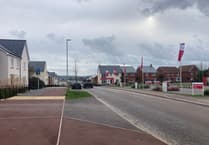Musgrove Park Hospital has introduced a state of the art surgical technique for spinal operations.
The new endoscopic spinal surgical system will allow surgeons to operate on a patients spine in a less invasive way - allowing for faster discharges and lower risks.
By inserting a 6mm camera into a patient's spine, surgeons can now operate on the bone without the need to cut open through a patient's back, reducing recovery time and pain.
The NHS Somerset Foundation Trust, which runs the hospital, is the first in the south west to buy an endoscopic spinal surgical system - which will make the new operations possible.
It is hoped the new equipment, and specialist surgeons, can see patients undergo spinal surgery and in some instances be discharged the same day.
Mr Ashok Subramanian, a consultant spinal surgeon at Musgrove said: "There are traditionally a number of risks involved in spinal surgery, particularly with the long incisions made into a patient’s body that often mean they need a long stay in hospital to recover. Even after the patient returns home, they tend to experience back pain for a while, with a slow recovery.
“Spinal surgery involves working close to lots of important structures in the body so surgeons need to be very careful during a procedure.
“Over the years technology has advanced and, as with every other speciality, spinal surgery is evolving too. For example, for knee problems like a meniscus tear – also known as a cartilage injury – we used to perform open knee surgery back in the 1980s, but this is now done by keyhole surgery with patients often going home on the same day with much less recovery time. In fact, it’s now possible for a patient to be back at their work or usual living activity within two weeks, with a reduced risk of infection or arthritis.
“There are, of course, some occasions where this is not possible – mainly for patients with more complex needs.
“Our new endoscopic spinal surgery technique involves inserting a camera into the patient’s spinal canal to remove a piece of bone, ligament, or disc – whatever is causing the problem. All this can be done through a camera under direct and magnified vision.
“One of the key advantages of the technique is that we don’t need to release any of the core spinal muscles, which reduces the chance of back pain for the patient.
“Even a microscope technique would need up to a 2cm incision, but this camera is just 0.6cm thick, so requires a very small incision, reducing any inflammation in the patient’s skin so their recovery can be much quicker with less post-operation pain.
“Another key advantage with this technique is that it can be performed under local anaesthetic so the patient is awake throughout the procedure and can even see it happening on the big screen if they want.
“During the pandemic this was a huge advantage as it meant we didn’t need to give patients a general anaesthetic, which was more complicated for aerosol generated procedures. Also, some patients simply aren’t able to have a general anaesthetic due to lung conditions or other medical issues, so this technique can really help them.
“Even if the technique doesn’t work for a patient, there’s no harm done and another option can be explored instead.”
Ashok has been performing spinal procedures using this technique since 2013 through his NHS practice in Scotland. He has continued to offer this locally in Somerset since his appointment in 2015.
“I was fortunate enough during my time as a registrar to train with the first surgeon to bring the procedure into the UK,” he continued.
“I’ve been really lucky to be an early innovator in this field and I was part of a team that was involved in the presentations to gain NICE guidance and accreditation for the procedure, which meant it could be used as a standard in NHS trusts.
“At present, only about five or six surgeons in the UK perform this procedure and I’m the only surgeon in the south west who uses it, which means we tend to see patients from across the region. It’s great for our NHS trust to be at the forefront where we can offer this service to our patients.
“Now that we have purchased the kit to carry out the procedure we hope to be able to increase its availability so it can benefit more patients.
“We are the only NHS trust in the south west to have purchased this equipment so we tend to treat patients across the whole region – in fact our catchment area for spinal surgery is one million people, including the island of Jersey.
“I also teach other surgeons how to perform the procedure, which is something I am very passionate about, and I visit hospitals who are starting to take it on so I can give them advice.”




